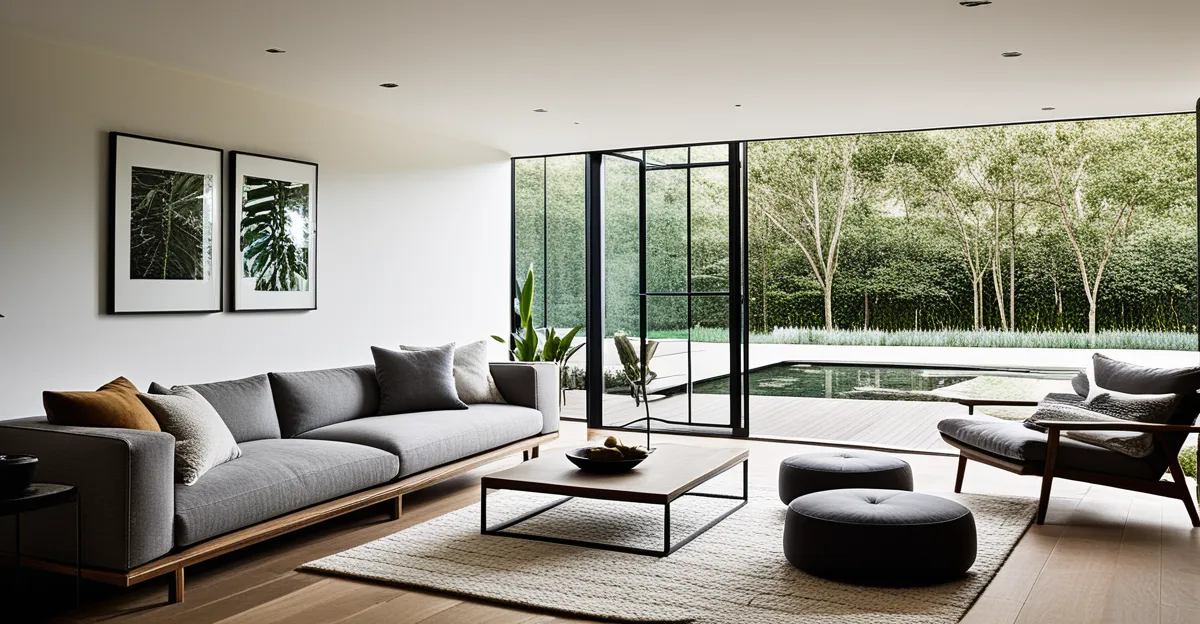Essential Elements of a Tranquil Living Room
Creating a tranquil living room design hinges on several key principles that foster a relaxing atmosphere and promote mental clarity. Central to peaceful home decor is simplicity—choosing minimalistic furnishings and calming colors to reduce visual noise. This approach cultivates openness and invites serenity.
A tranquil living room benefits wellbeing by lowering stress levels and encouraging restful moments. It serves as a sanctuary where one can unwind after busy days, playing a crucial role in emotional balance and overall health.
Also to discover : How Can Incorporating Traditional UK Home Decor Enhance Your Living Space?
To transform your space into a peaceful retreat, consider these elements:
- Soft, natural lighting to soothe the eyes
- Comfortable seating arranged to promote conversation or quiet reflection
- Strategic use of indoor plants or natural materials like wood to introduce gentle, organic textures
- Thoughtful organization that avoids clutter and keeps the environment neat
By integrating these components, your living room becomes more than a functional area—it becomes a deliberately crafted haven supporting calmness and renewal. This foundation paves the way for other design choices, such as color schemes and textures, which enhance tranquility further.
Also to read : How Can You Enhance Your Living Space with Simple DIY Projects?
Choosing Calming Color Schemes
Selecting the right calming colors is fundamental to achieving a tranquil living room design that fosters a truly relaxing atmosphere. Paint color ideas centered on neutrals like soft beiges, gentle greys, and off-whites provide a restful palette that soothes the mind without overwhelming the space. Pastel shades such as muted blues, blush pinks, or sage greens promote serenity by evoking natural elements and encouraging emotional balance.
Color psychology highlights how these hues directly influence mood: earthy tones create stability and warmth, while cooler shades induce calm and reduce stress. Applying a cohesive color strategy across walls, textiles, and accents can unify the space, enhancing the peaceful home decor. For example, pairing a pale wall color with cushions or rugs in complementary pastels deepens the visual tranquility while adding subtle depth.
To integrate calming colors effectively, consider painting main walls in muted neutrals, then layering with textile accessories in soothing pastels or earth tones. This approach offers flexibility, letting you adjust accents seasonally or as your preferences evolve without overwhelming your living room’s core serenity. Thoughtful coordination between paint and fabrics is key to maintaining a balanced and inviting environment that invites relaxation at every glance.
Selecting Relaxing Furniture and Arrangements
Designing a tranquil living room design revolves around selecting comfortable furniture that supports both relaxation and aesthetic balance. Ergonomic seating with soft cushions and gentle curves invites extended rest without strain. Minimalist pieces reduce visual clutter, reinforcing a peaceful home decor that soothes the mind.
A smart layout enhances flow and openness, fundamental to sustaining a relaxing atmosphere. Place furniture to encourage natural movement paths and connection, avoiding overcrowding. For example, orient sofas and chairs in conversation-friendly groupings but maintain ample space around them. Integrating multi-functional furniture, like ottomans with storage, contributes to tidiness and calmness.
Product suggestions include plush armchairs with breathable fabrics, low-profile sofas in muted tones, and simple wooden coffee tables that add warmth without distraction. These selections support tranquility by balancing comfort, style, and functionality.
Thoughtful planning of furniture and arrangement not only establishes an inviting space but also reinforces the tranquil living room’s purpose—to create a calm refuge amid daily life. This approach ensures that each piece serves a role in fostering peace, wellbeing, and effortless relaxation.
Decluttering and Organising for Peace
Maintaining a tranquil living room design relies heavily on effective decluttering tips that simplify your space and ease the mind. Start with early decluttering by sorting items into keep, donate, and discard piles to prevent overwhelm. Prioritising essentials creates a minimalist living room where open surfaces and clear floors promote a truly relaxing atmosphere.
Smart storage solutions help keep chaos at bay. Consider built-in shelves, concealed cabinets, and multifunctional furniture with hidden compartments to store belongings discreetly. These approaches maintain orderly surfaces, crucial for sustaining peaceful home decor and preventing visual noise.
Regular maintenance habits ensure ongoing tranquillity. Set daily or weekly routines to tidy up, returning items to their proper places. Habitual organisation reduces disruptive mess and supports mental clarity.
By integrating thoughtful decluttering and organised storage, your living room transforms into a serene environment. This foundation of neatness amplifies the calming impact of other design elements, strengthening your space’s ability to foster rest and wellbeing.
Optimising Soft Lighting for Relaxation
Soft lighting is a cornerstone of tranquil living room design, crafting a gentle, inviting living room ambience that fosters a relaxing atmosphere. Layered lighting allows you to adjust brightness according to mood or activity, helping to signal relaxation and reduce eye strain.
Incorporating a variety of light sources—such as table lamps with warm bulbs, string lights, and candles—adds depth and softness. For example, placing a dimmable lamp beside a cozy armchair creates a calming nook, while candles contribute flickering warmth without harsh glare.
Natural light plays an equally vital role. Maximising daylight through sheer curtains or strategic mirror placement enhances mood and connects indoor spaces with nature’s rhythms. Soft morning or late afternoon sunlight is especially soothing, reinforcing peaceful home decor goals.
Effective soft lighting balances practicality with ambience. It reduces stark contrasts and sharp shadows that can jar the senses. By thoughtfully layering adjustable lamps and encouraging the flow of natural light, your tranquil living room design becomes a luminous haven that supports wellbeing and downtime effortlessly.
Incorporating Natural Elements and Houseplants
Bringing indoor plants into your living room is a powerful way to deepen a tranquil living room design. Plants like peace lilies, snake plants, and pothos not only enhance air quality but also introduce a calming touch of nature. Their lush greenery evokes biophilic design principles, which connect indoor spaces to the natural world, fostering a relaxing atmosphere.
Arranging greenery thoughtfully balances aesthetics with serenity. Cluster smaller pots at varying heights or place a large statement plant near seating to create visual interest without clutter. Consider pots in neutral tones or natural materials to complement your peaceful home decor seamlessly.
Beyond plants, incorporating other natural decor elements like smooth river stones, wooden bowls, or woven baskets enhances texture and warmth. Using natural fibres—like jute rugs or linen throws—further grounds the space, amplifying calmness through tactile experience.
Together, these organic touches cultivate an environment that soothes the senses and promotes wellbeing. Thoughtful integration of natural decor not only enriches appearance but also creates a sanctuary that feels alive and restorative every day.

